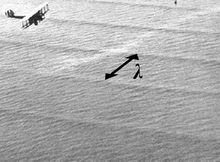Wavelength
A wavelength is the length of the shortest repeating part of a "sine wave". All waves can be formed by adding up sine waves. That is, every wave is a total of sine waves, which may be identified by Fourier analysis. It is also known as the distance between a crest and another crest of a wave (highest point above equilibrium) or the distance between a trough and another trough of a wave (lowest point below the equilibrium of a wave).


Examples of waves
changeWaves are everywhere. Examples of waves include:
- sound
- electromagnetic spectrum including
- water waves such as ocean surface waves
- earthquake waves
"Length" of a sine wave
changeThe sine wave has a pattern that repeats. The length of this repeating piece of the sine wave is called the wavelength. The wavelength can be found by measuring the length or distance between one peak of a sine wave and the next peak. The wavelength can be found in many other ways too. As the frequency of a wave increases, the wavelength decreases Thus, the frequency and wavelength are in inverse proportionality.
There are other properties of waves and sine waves, such as their frequency, amplitude, phase, and speed.
A symbol used for wavelength most often is the Greek letter lambda (λ).